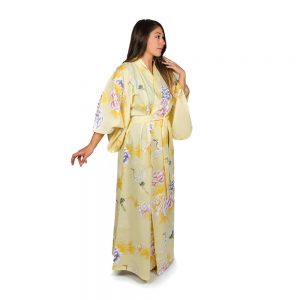The kimono is a traditional Japanese garment with a rich history and symbolism. Dating back to the Heian period, kimonos were originally worn by the nobility and upper class as a status symbol. Over time, kimonos became more widely available. They continued to be associated with important occasions and formal events. Today, kimonos are still worn for special occasions, but they have also become popular as fashion wear. Kimonos are worn daily around the home or for special events and a night out. Yukata, or casual kimonos, are often worn during summer festivals or at hot springs.
Japanese kimonos are frequently decorated with colorful patterns and symbols that hold special meanings. Many of these symbols are derived from nature, such as flowers and animals. Other common symbols include waves, mountains, and cherry blossoms. Each symbol has its significance, and kimono designers take care to create unique combinations that will convey the desired message. For example, a kimono adorned with images of Mt. Fuji and waves might be meant to represent the strength and beauty of Japan. In this way, the symbolism of the kimono can be used to communicate messages of respect, admiration, or even love.
SYMBOLS FOUND IN KIMONOS AND WHAT THEY REPRESENT
Kimonos and yukatas are traditional Japanese robes that often feature a variety of symbols. These symbols can represent a wide range of concepts, from the natural world to aspects of the wearer’s personality. Common motifs include trees, flowers, and animals. The crane, for example, is a symbol of good luck, while the dragon represents strength and power. Pine trees are associated with longevity, and cherry blossoms represent the ephemeral nature of life. In addition to these traditional symbols, kimonos and yukatas may also feature more modern designs, such as geometric patterns or abstract shapes. No matter what the design, each kimono or yukata is a work of art that reflects the taste and personality of the wearer.
HOW TO INTERPRET THE SYMBOLISM WHEN LOOKING AT A KIMONO
The kimono is one of the most iconic garments in Japanese culture. Originally reserved for special occasions, kimonos are now worn by men, women, and children daily. Though the kimono has undergone many changes over the centuries, it remains an important part of Japanese life. When looking at a kimono, there are several things to keep in mind. Originally, the kimono was usually made of silk, which is a symbol of wealth and prosperity. Today, cotton is the most common choice due to its easy-care qualities and price. The kimono is often brightly colored and decorated with intricate patterns. These patterns can be symbolic of different things, such as nature or the seasons. Finally, the kimono is traditionally worn with a sash called an obi. The obi can be tied in different ways, each of which has its meaning. By keeping these things in mind, you can begin to interpret the symbolism of the kimono.
KIMONOS WITH INTRICATE PATTERNS
One of the most famous kimonos is the ume kimono, which features a pattern of plum blossoms. The plum blossom is a symbol of resilience and strength, as it is one of the first flowers to bloom in spring after a long winter. Another popular kimono is the Kiku kimono, which features chrysanthemums. Chrysanthemums are associated with royalty in Japan, and they are also considered to be lucky flowers. Kimonos with these types of patterns are often worn by brides on their wedding day.
THE FUTURE OF JAPANESE SYMBOLISM AND ITS POTENTIAL INFLUENCE ON WESTERN FASHION
There is no doubt that Japanese fashion is having a moment. Celebrities and everyday people alike are embracing the kimono, yukata, and other Japanese-inspired garments. But what does the future hold for this trend?
Some experts believe that Japanese symbolism will continue to grow in popularity, especially among young people. With the rise of social media, it’s easier than ever to connect with others who share your interests. And as more and more people adopt Japanese fashion as their own, the influence of Japanese culture on the Western world is likely to increase.
So what does this mean for Western fashion? It’s impossible to say for sure. But we may see more Japanese-inspired clothing and accessories in the years to come. Perhaps we’ll even see a resurgence of kimono-wearing in the West! Only time will tell. The kimono is a truly unique article of clothing, and it continues to be an important part of Japanese culture.
Chopa – Your Kimono Source offers a wide variety of Japanese Kimono, Yukata, and short-length Happi Coats. Shop online now!
Tags: japanese kimono, japanese robe, kimono, Yukata









I have always thought I was wearing a piece of art when I slip into one of my kimonos. It’s nice to see why people believe that. I feel kimonos are the most underrated robe in the world. They are so beautiful and stylish.